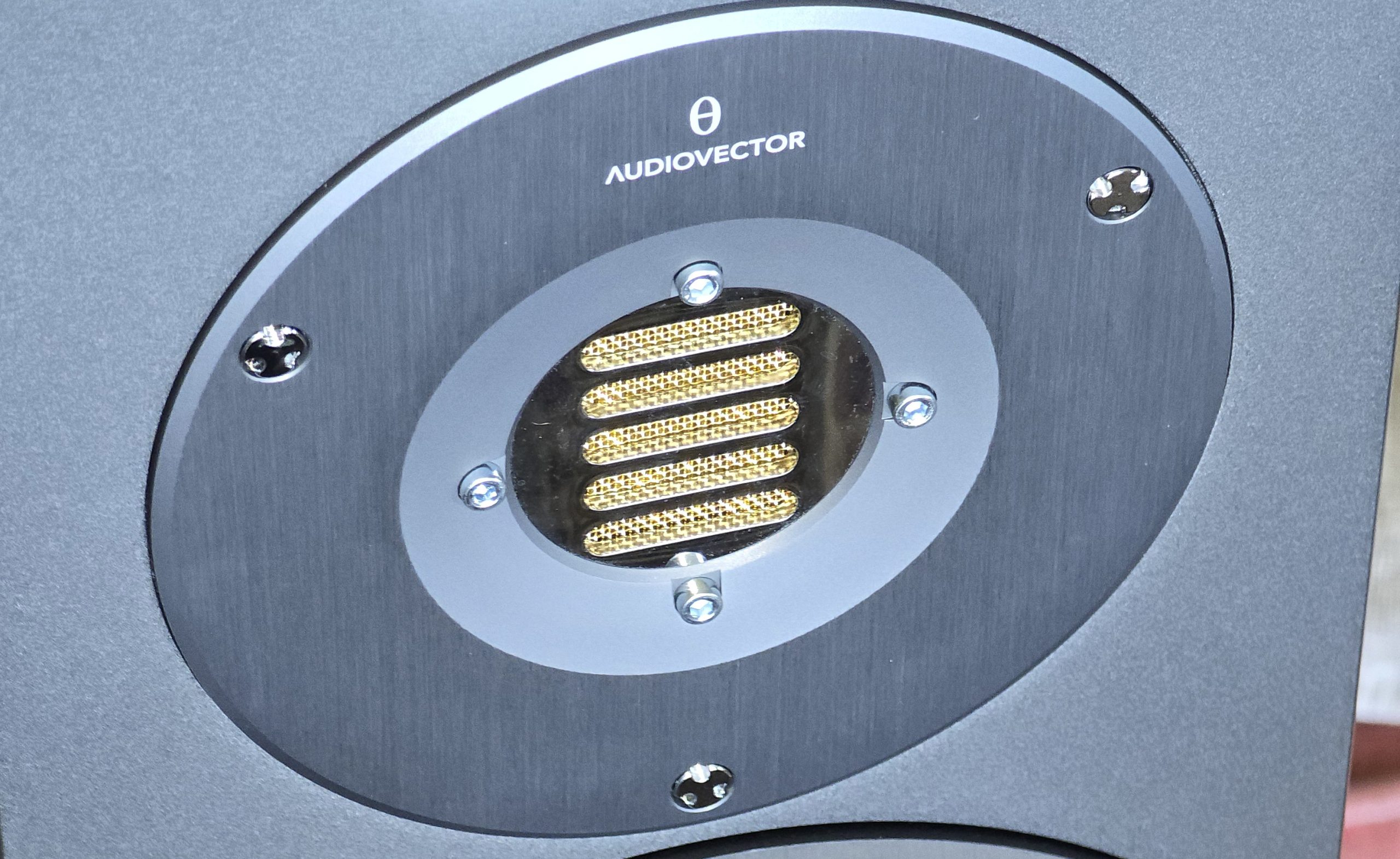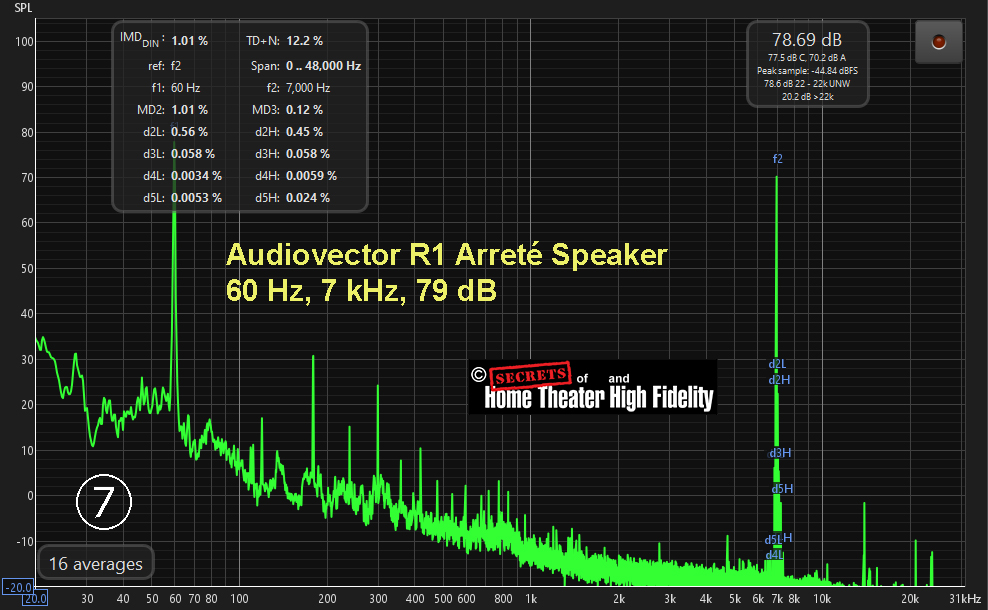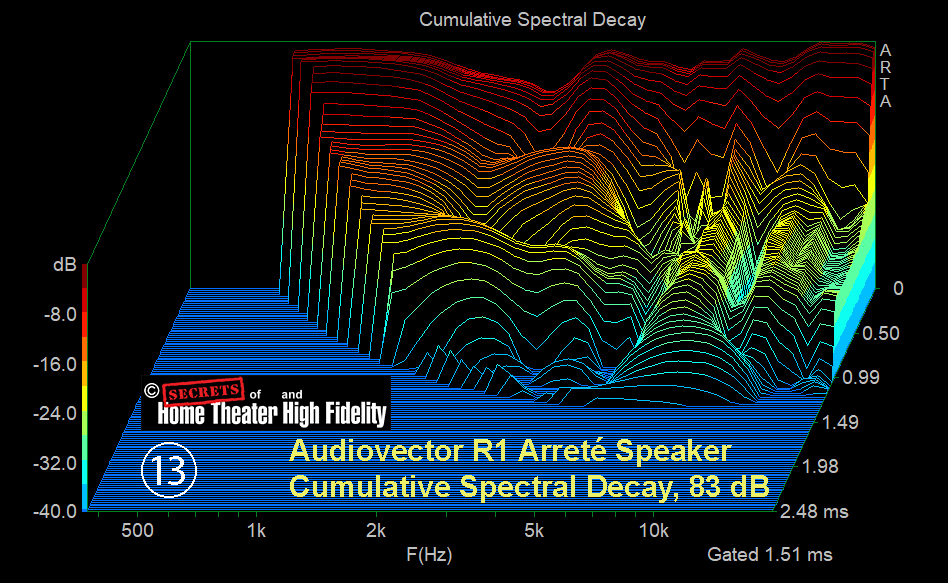Their enclosure finish can be customized, and the review units were a beautiful piano gloss deep blue.
Audiovector R1 Arreté Stand-mounted Speakers Highlights
- Beautiful build quality
- Big, bold sound
- Unusual grounding feature
Audiovector is a speaker manufacturer in Denmark, and its product array is enormous. They have been in business since 1979.
From various sources comes the following information about the company:
Ole Klifoth founded Audiovector in Copenhagen in 1979 after becoming disillusioned with the loudspeakers available at the time. Klifoth, who has a passion for music and audio and has experience in the hi-fi industry, wanted to create his own ideal loudspeaker for the high-end market. The company’s design philosophy is based on Klifoth’s ideas about linear dynamics, linear phase, and low compression.
Klifoth’s vision was then, and still is, to produce natural-sounding loudspeakers for music lovers. He came from other parts of the hi-fi industry and started Audiovector, because as he says: “I could not find the speaker of my dreams, so I decided to build it myself.”
As a new company, Audiovector enjoyed a successful start with the “Trapeze” speaker, built according to Ole Klifoth’s ideas about linear dynamics, linear phase, and low compression. These ideas form the backbone of Audiovector’s design philosophy. The history of Audiovector is described through its iconic products over the years.
Mads Klifoth, Ole’s son, is the current CEO of Audiovector.
Here is the complete R Series.
Build Category:
Stand-mounted
Driver Category:
Two-way
Ported:
Yes
Tweeter:
AMT (Air Motion Transformer)
Woofer:
6.5″ Carbon Fiber
Frequency Response:
38 Hz – 53 kHz (-6 B)
Sensitivity:
87 dB, 1 Watt @ 1 Meter
Nominal Impedance:
8 Ohms
Crossover Frequency:
2,900 Hz
Power Handling:
200 Watts
Dimensions:
29 × 37 × 19.6 cm (11.4 in x 14.6 in x 7.7 in)
Weight:
22 Pounds
MSRP:
$6,250/pair in standard finish
Website:
Company:
SECRETS Tags:
Audiovector, R1, Arreté, stand mounted speakers, Bookshelf Speakers, loudspeakers, speakers
Secrets Sponsor
This two-way design has a “teardrop” shape to minimize internal reflections. Besides the tuned port on the rear, an additional opening above the port allows sound to project rearwards. In the photo below, you can see the port has a screen covering the opening, which adds a slight resistance. The additional opening is at the top, and it also has a screen covering.
The R1 Arreté comes with magnetically attached grilles, two binding posts, and a terminal for an optional grounding cable, which can be purchased for $750. The cable has a single grounded three-prong AC plug that does not have the two voltage prongs connected to anything – only the ground prong is connected. Two cables are connected to the single AC plug. One cable goes to one speaker, and the other cable goes to the second speaker. The cable is expensive because it has to be hand-made specifically for this purpose.
The ground terminal on the rear of the speaker is connected to a separate crossover network inside the enclosure that is distinct from the main crossover network. It serves to neutralize back-EMF voltage (EMF stands for Electromagnetic Fields) that is generated by the voice coils of the drivers (mainly the woofer) when inertia carries them past the 0 Volts points of musical waveforms (where the positive portion of the waveform crosses over to the negative portion – see figure below). The back EMF from the woofer could theoretically affect the tweeter since both drivers are connected together in the main crossover network. By using a special supplementary crossover network, the EMF could be dissipated as heat or removed through the ground terminal. It is possible that mechanical resonance frequencies of the metal frames of the tweeter and woofer and cabinet resonances could induce back EMF voltages as well. The supplementary crossover could dissipate these voltages, although they are likely to be small.
Depending on the output impedance of the power amplifier driving the speakers, such back-EMF can be eliminated by the amplifier’s current drain characteristics, but the separate crossover network for the grounding circuit does this regardless of the power amplifier. Tube amplifiers often have (relatively) high output impedances, such as 5 Ohms, compared to solid state amplifiers which have less than 1 Ohm output impedance.
So, a tube amplifier with its high output impedance cannot serve as a current drain because of its output resistance, and it has what is called a low damping factor. The EMF generated by the speaker drivers, most significantly the woofer, causes the woofer to sound “floppy”, because of that tube amplifier’s low damping factor. The special crossover network in the R1 Arreté speakers drains that EMF.
As to a definition of the damping factor (DF), it is the ratio of the load impedance (speaker plus wire resistance) to the amplifier’s internal output impedance. This determines the amplifier’s ability to control the overshoot of the loudspeaker, i.e., to stop the cone from moving due to inertia.
In my listening tests, whatever effect the ground cable had was very subtle, perhaps making the sound “tighter” (more damping), but it really needs a double-blind test to ensure this. I think that a lot of the benefit from the crossover network that is specifically designed to reduce electrical interaction of EMF between the drivers is accomplished without the ground cable, as the separate crossover network dissipates the EMF as heat.
The R1 Arreté is available in four standard finishes: African Rosewood, Italian Walnut, Black Ash, and White Silk. Custom piano gloss finishes are available for an extra $312 (£250).
The tweeter for the R1 is AMT (Air Motion Transformer), which is hand-made by Audiovector.
According to Wikipedia, “In contrast to a planar ribbon loudspeaker, the diaphragm of the AMT is of pleated shape similar to a bellows. The AMT moves air laterally in a perpendicular motion using a metal-etched folded sheet made of polyethylene terephthalate (PET) film. The circuit path embossed on the PET membrane, acts as the voice coil unit. The diaphragm (now, as a unit) is then housed between 4 stacks of steel pole-plate pieces positioned at 45° within a high-intensity, quadratic, opposing magnetic field. The air motion transformer with its sheet film equally exposed at 180° behaves as a dipole speaker, exciting front and rear sonic waves simultaneously.
The diaphragm pushes back and forward from itself in a physical motion similar to that observed when an accordion is pushed in and pulled out to pump air through the reed chambers, albeit over an exceedingly smaller motion range. The result is a dipole driver with an extraordinarily rapid response rate, enabled by the extremely low mass of the polyethylene substrate and the far smaller distance it travels on each “swing” compared to a dynamic driver. In this technical respect, it shares characteristics with an electrostatic driver.”
The woofer has a 6-1/2″ carbon fiber cone with a phase plug which is stationary (it does not move with the cone).
The teardrop shape of the enclosure is shown in the following photo. The wood for the enclosure has to be steam-bent to achieve this. Complex internal baffles help to reduce reflections and stabilize the enclosure to reduce resonances. Plenty of polyurethane finish coats are applied and hand-polished. This sort of construction is one reason the speakers are rather expensive. They are very time-consuming to build.
I listened to the Audiovector R1 Arreté speakers using Qobuz high res streaming through a lab-grade soundcard as a preamplifier, to Parasound JC 1+ Monoblock Power Amplifiers.
I am going to get away from posting a lot of new album cover art because the sounds I am looking for are standardized for me. A listener’s opinion of the sound depends on sound preferences, other equipment used, the listener’s room, and the music chosen for the listening tests. None of these things are consistent from listener to listener, so it is impossible to equate listening tests between different reviewers because there are too many variables. Also, there are only so many adjectives that can be used to describe the sound, and they are constantly used in product reviews of components at all price levels. There remains almost nothing to distinguish one product from another.
If only newly released albums are used for listening tests, the listener could hear a difference in the ability to reproduce certain sounds due to differences in the recordings from what he (she) heard recently with his (her) own reference equipment and from what he (she) heard with the last speakers reviewed. So, it is best to make the primary listening opinions on a set of “standard” recordings chosen for their wide variety of sounds, such as violins, piano, deep bass, male voices, and female voices. Of course, new releases can be listened to as well, but the opinions should be based mainly on the standard set of recordings.
Here is a graphic showing my “standard” albums, where I know what they should sound like from having listened to them many times with different review products. You can click on the figure to see it full size.
I want to keep it simple for my subjective opinions. The bench tests are much more important to me, as they are the only results that can be duplicated between testers in different places. That is a basic tenet of scientific methods.
Here are my listening opinions of the Audiovector R1 Arreté speakers, having listened to a lot of music with them, using them as stereo speakers and using them as front left and right channel speakers in my home theater:
1 – Plays loud without much audible distortion. – Yes
2 – Violins sound clean and natural – Yes, excellent edge transients
3 – Sweet high-end rather than edgy, irritating sound – Yes
4 – Human voices natural – Yes
5 – Detailed – Yes, the tweeter has low distortion
6 – Congestion at high volume – Within reason for size of speaker
7 – Midrange prevalence – No
8 – Sibilance – Medium/high
9 – Powerful, punchy bass – Yes
10 – Bass boominess – Some, but expected with this size of woofer and its large output
To me, soundstage is not something a speaker is responsible for. Its purpose is to make a trumpet sound like a trumpet and not be confused with a French horn, a violin to sound like a violin and not be confused with a piccolo, a string bass to sound like a string bass and not like a bass drum (boominess). Soundstage is a result of how the music is recorded, where the instruments were in relation to all the microphones (of which there may be many, especially with symphonic orchestras), and how the recorded tracks are mixed. It is affected in the listening room by how far apart the speakers are, how far away the listener is, toe-in of the speakers, the floor, the ceiling, doorways, windows, etc.
In any case, I am quite impressed with the Audiovector R1 Arreté Speakers. In particular, the AMT tweeter is very special, producing a really smooth sound. I wish cone woofers could perform like that.
Secrets Sponsor
At 50 Hz (Figure 1 below), with a 1 kHz sine wave set to 85 dB SPL, the output was 74 dB SPL. Distortion was 1.46% and primarily 2nd-ordered. 
At 100 Hz (Figure 2), the output was higher (88 dB SPL) than at 50 Hz (this is expected due to the size of the woofer), with distortion lower at 0.18%, but it is 3rd-ordered rather than 2nd-ordered.
At 1 kHz (Figure 3), which is a standard test frequency, distortion was 0.14% at 86 dB SPL. It was primarily 3rd-ordered.
5 kHz is only a standard test frequency for me, Here (Figure 4), the output is 83 dB SPL, and distortion, at a low 0.12%, is primarily 2nd-ordered. At this point, the sound was coming from the tweeter (crossover is 2.9 kHz).
A 10 kHz sine wave at 84 dB SPL (Figure 5) yielded 0.09% distortion, and it was primarily 2nd-ordered. This is very good and is why an AMT tweeter is becoming very common in new speakers. Very low distortion compared to conventional tweeters.
With a 20 kHz signal (Figure 6), I can’t display the harmonics at 40 kHz due to the 30 kHz limit of the calibrated laboratory-grade microphone (Earthworks), but the calculated distortion was 0.16%.
Now we move on to Intermodulation Distortion (IMD). The input signals for this basic test are 60 Hz and 7 kHz at a 4:1 ratio. Figure 7 (below) shows the results with an output of 79 dB SPL. Note that the 60 Hz signal comes out of the woofer, and the 7 kHz signal comes out of the tweeter. What this test shows is how the outputs of the two drivers interact with each other on their way to the microphone (or listener’s ears). IMD was 1%.
Figure 8 below is the same spectrum as in Figure 7 above, but with an expanded X scale to show the individual IM peaks.
The use of 19 kHz and 20 kHz sine waves is also an IMD test. Here (Figure 9), at 86 dB SPL, IMD was 0.16%. Both test signals were coming out of the same driver (tweeter). Again, this is a testament to the AMT tweeter hand-built by Audiovector for their speaker line.
The above spectrum (Figure 9) with an expanded X scale is shown below in Figure 10. There are no high-side peaks. They are all very low. That AMT tweeter is something else!
A 1/10th decade test (very stressful) at 85 dB SPL is shown below in Figure 11. Distortion is primarily in the midrange at about 1.2 kHz.
Using an Impulse Response test at an average of 83 dB SPL, and then plotting the Frequency Response and Distortion (Figure 12), we can see that there is quite a bit of distortion from the woofer, but not very much from the tweeter. Notice that at the crossover frequency of 2.9 kHz, the distortion transitions from 3rd-ordered (woofer) to 2nd-ordered (tweeter).
The bass is very strong with these speakers, but the price for this is a bit of boominess. If you would use a subwoofer with these speakers for the deep bass, I would suggest putting a foam plug in the Arreté woofer port and adjusting the subwoofer crossover. You can buy foam plugs on Amazon. However, Audiovector engineers recommend just using a subwoofer crossover frequency in your processor settings rather than the foam plug.
In Figure 13, below, the Cumulative Spectral Decay (CSD) is shown (also derived from the Impulse Response). Resonances are pretty well controlled.
A Step Response measurement is shown in Figure 14. It is also derived from the Impulse Response. The drivers are in-phase (positive front portions of the waveform for the tweeter and woofer). The wave from the port is at the end.
And, lastly, the Impedance/Phase plot (Figure 15). The Impedance maximum is 31.5 Ohms at 85 Hz, and the minimum is 7 Ohms at 200 Hz. The maximum Phase is +44° at 18 Hz, and the minimum Phase is – 48° at 100 Hz.
The Audiovector R1 Arreté Speakers are as excellent sounding as they are beautiful.
- Gorgeous
- Detailed sound with 2nd-ordered high frequency distortion
- Unique design to reduce electrical interaction between the drivers
- Larger woofer (8″)
- Thicker grilles
They would make fine stereo speakers and/or front main left and right speakers in a home theater.

























